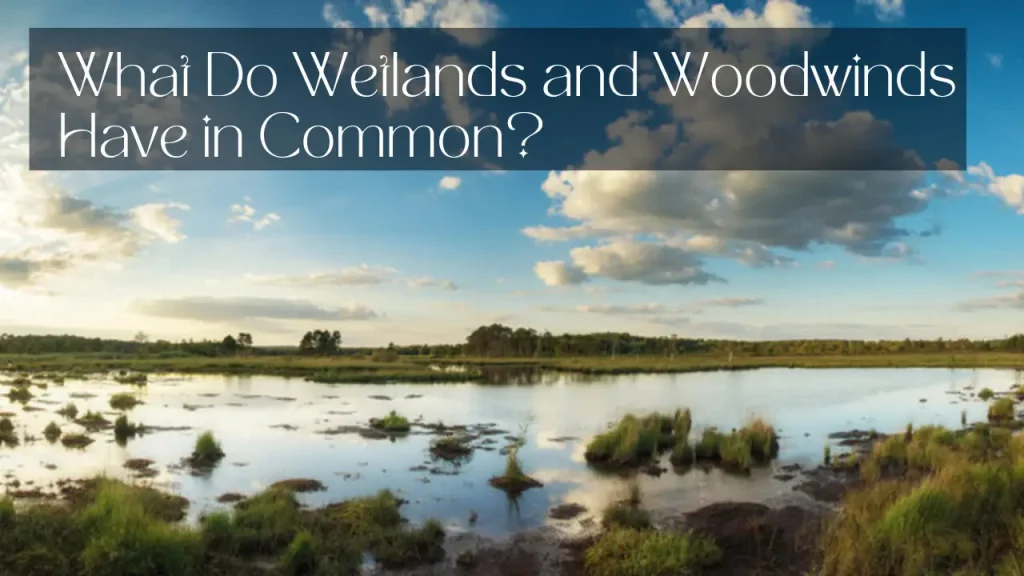
Wetlands and woodwinds might seem unrelated at first glance, but both play crucial roles in their respective domains.
Wetlands are unique ecosystems where water plays a central role in shaping the environment, while woodwind instruments are a diverse family of musical instruments that produce sound through air vibrations.
Despite their apparent differences, they share intriguing commonalities that highlight their significance in both ecological and cultural contexts.
Purpose of the Article
This article aims to explore the shared characteristics and significance of wetlands and woodwinds.
By delving into their definitions, roles, and impacts, we can uncover how these two seemingly disparate topics intersect in ways that enrich our understanding of both nature and culture.
Defining What Do Wetlands and Woodwinds Have in Common?
What Are Wetlands?
Wetlands are areas where water covers the ground or is present near the surface for extended periods. This presence of water creates a distinctive environment that supports a variety of plant and animal species.
- Types: Wetlands include swamps, marshes, bogs, and fens. Each type has its own specific characteristics:
- Swamps: Dominated by trees and shrubs.
- Marshes: Characterized by herbaceous plants like grasses and reeds.
- Bogs: Accumulated peat and acidic waters support sphagnum moss and fewer plant species.
- Fens: Less acidic than bogs, with a diverse range of plant species.
Wetlands act as natural water filters, trapping pollutants and sediments. They also provide crucial habitats for wildlife and help manage floodwaters by absorbing excess rain.
What Are Woodwind Instruments?
Woodwind instruments produce sound by air vibrating through them. The sound is generated either by blowing air across an opening or through reeds.
- Types: Woodwinds include flutes, clarinets, oboes, and bassoons. Each type has distinct characteristics:
- Flutes: Produce sound by blowing air across an edge.
- Clarinets: Use a single reed to create sound.
- Oboes: Employ a double reed for sound production.
- Bassoons: Also use a double reed but have a lower pitch range.
Woodwinds are essential in various musical genres, including classical, jazz, and folk. They add unique tonal qualities to musical compositions and performances.
Ecological and Cultural Roles
Ecological Roles of Wetlands
- Biodiversity: Wetlands are rich in species diversity, hosting a range of organisms from amphibians and birds to fish and invertebrates. For example, the Everglades in Florida support over 350 bird species and numerous other wildlife.
- Water Filtration: Wetlands filter pollutants such as nitrogen and phosphorus from water, improving water quality before it flows into rivers and lakes. They may be a great source of entertainment for vacation tours and adventure.
- Flood Protection: By absorbing and slowly releasing water, wetlands reduce the risk of floods and help maintain water levels in downstream areas.
Cultural Roles of Woodwinds
- Musical Heritage: Woodwind instruments have been integral to classical music for centuries, from Beethoven’s symphonies to modern jazz compositions. For instance, the clarinet has been a staple in orchestral music since the 18th century.
- Cultural Expression: These instruments are used in diverse musical traditions around the world, including Indian classical music, where the bansuri (a type of flute) plays a significant role.
- Emotional Impact: Woodwinds can evoke a wide range of emotions, from the melancholic tones of the oboe to the joyful sound of the flute, enhancing the storytelling aspect of music.
Biodiversity and Community Impact
Biodiversity in Wetlands
Wetlands support a diverse range of species, including plants like cattails and animals like the American alligator. The Okavango Delta in Botswana is home to over 400 bird species and various large mammals.
Ecosystem Services: Wetlands contribute to ecological balance by providing habitats, supporting species survival, and maintaining water quality.
Biodiversity of Woodwind Instruments
Each woodwind instrument offers a unique sound profile, contributing to the global music landscape. For example, the piccolo produces a bright, piercing sound, while the bassoon has a deep, resonant tone.
Cultural Diversity: Woodwinds reflect various musical traditions and practices, from the ancient Egyptian use of flutes to modern jazz clarinets.
Community and Connectedness
- Wetlands: Community efforts to conserve wetlands, such as the restoration projects for the Mississippi River Delta, foster a shared sense of purpose and responsibility. Recreational activities like bird watching and hiking also bring people together
- Woodwinds: Music groups, such as school bands and community orchestras, provide opportunities for social interaction and cultural exchange. Educational programs in music foster a sense of community and shared cultural heritage.
Educational and Research Value
Educational Value of Wetlands
Wetlands serve as natural laboratories where students and researchers can study ecosystems, water cycles, and environmental changes. For example, the study of wetland ecosystems helps researchers understand climate change impacts.
Research: Wetlands research focuses on topics such as biodiversity conservation, water quality management, and climate adaptation strategies.
Educational Value of Woodwind Instruments
Woodwind instruments are central to music education, teaching students about music theory, history, and performance techniques. Music programs often include learning about the history and mechanics of these instruments.
Exploring the role of woodwinds in various cultures enhances understanding of global musical traditions and practices.
Economic and Recreational Benefits
Economic Benefits of Wetlands
- Industries: Wetlands support industries such as fishing and hunting, contributing to local economies. The Great Lakes support commercial fisheries that are vital to the region’s economy
- Resources: Wetlands provide valuable resources, including peat for fuel and medicinal plants used in traditional medicine.
- Recreational Activities: Wetlands offer recreational opportunities such as bird watching, kayaking, and hiking, which can boost local tourism economies.
Economic Benefits of Woodwind Instruments
- Industry: The production and sale of woodwind instruments contribute significantly to the economy. High-quality instruments made by skilled craftsmen can be quite valuable.
- Craftsmanship: Music stores and instrument manufacturers support jobs and local economies, from crafting instruments to selling them.
Challenges and Conservation Efforts
Challenges for Wetlands
- Environmental Threats: Wetlands face threats from pollution, habitat destruction, and climate change. For example, wetlands are increasingly drained for agriculture and urban development.
- Conservation Efforts: Effective conservation strategies include wetland restoration projects, pollution control measures, and protective legislation to prevent further degradation.
Challenges for Woodwind Instruments
- Accessibility: Access to quality woodwind instruments and music education can be limited in some areas, impacting the development of young musicians.
- Preservation: Maintaining traditional techniques and ensuring the availability of high-quality instruments require ongoing support from cultural organizations and musicians.
Conservation Efforts
- Wetlands: Conservation efforts involve sustainable management practices, protection from development, and restoration initiatives to preserve wetland ecosystems.
- Woodwinds: Promoting music education programs and supporting cultural traditions help preserve the value of woodwind instruments and ensure their continued appreciation.
Conclusion
Wetlands and woodwinds share several important qualities, including their contributions to biodiversity, community building, and cultural significance.
Both play vital roles in their respective areas—wetlands in maintaining ecological balance and woodwinds in enriching cultural heritage.
Readers are encouraged to support efforts to conserve wetlands and promote music education.
By understanding and appreciating these commonalities, we can work towards preserving both natural environments and cultural traditions for future generations. As it is a healthy comparison of different aspects it may encourage the peoples for protection of environment and old entertainment.
Frequently Asked Questions (FAQs)
1. What are wetlands and woodwind instruments?
Wetlands are natural areas where water covers the ground, like swamps and marshes, and they are important for filtering water and providing habitats for wildlife. Woodwind instruments are musical instruments, such as flutes and clarinets, that produce sound when air is blown through them.
2. How do wetlands and woodwind instruments support biodiversity and culture?
Wetlands support biodiversity by offering habitats for a wide variety of plants and animals, helping maintain ecological balance. Woodwind instruments support cultural diversity by being central to different musical traditions and styles, allowing people to express emotions and share stories through music.
3. What educational benefits do wetlands and woodwind instruments offer?
Wetlands provide a natural setting for studying ecosystems, climate, and water cycles, making them valuable for environmental education. Learning to play woodwind instruments teaches music theory, performance skills, and an appreciation for cultural history.
4. What economic and recreational benefits do wetlands and woodwind instruments provide?
Wetlands contribute to the economy through industries like fishing and tourism, and offer recreational activities like bird watching. Woodwind instruments contribute economically through their production and sale, and they play a key role in music performances and events.
5. What are the main challenges faced by wetlands and woodwind instruments?
Wetlands are threatened by pollution and habitat destruction, which can harm their ability to support wildlife. Woodwind instruments face challenges like limited access to quality instruments and the need to preserve traditional playing techniques.
6. How can we support the conservation and appreciation of wetlands and woodwind instruments?
We can support wetlands by protecting them through sustainable practices, restoration projects, and reducing pollution. For woodwind instruments, we can promote music education, preserve cultural traditions, and encourage high-quality instrument craftsmanship.
7. What do wetlands and woodwind instruments have in common?
Both wetlands and woodwind instruments play crucial roles in their respective fields—wetlands in environmental health and biodiversity, and woodwind instruments in music and culture. They both offer significant educational, recreational, and economic benefits and face challenges that require conservation and appreciation efforts.


